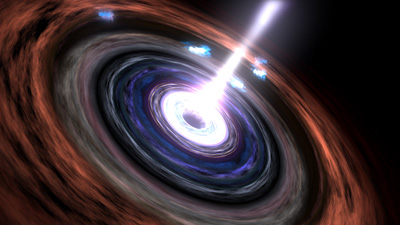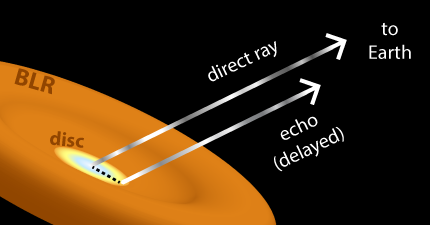
Artist's impression of the accretion disc surrounding the supermassive black hole at the centre of an active galactic nucleus. Image © 2008 NASA/Goddard Space Flight Center Conceptual Image Lab.
A recent paper by Ian McHardy et al reveals insights into the structure of the accretion disc surrounding the supermassive black hole at the centre of the active nucleus (AGN) of galaxy NGC 4395.
It's long been known that most galaxies harbour supermassive black holes (SMBHs) at their centres. Surrounding the black holes in some galaxies, known as Active Galaxies, are accretion disks of hot gas spiralling in to disappear beyond the event horizon at the disk's centre. In the very inner parts, immediately surrounding the black hole, is an intensely hot region emitting X-rays.
Most of the X-rays escape and can be directly observed by space observatories. However a significant fraction of the X-rays spread out across the disc itself. These X-rays interact with the matter there and are re-emitted in a wide range of energies. The X-rays are "reprocessed" into UV light near to the SMBH, and into optical wavelengths of decreasing energy the further out in the disc you go, as the disc is cooler further out.
Still further out lies an inflated region of gas. The high energy photons from the central X-ray and UV emitting regions excite the atoms in the gas causing them to re-emit both optical emission lines and optical continuum emission. The rapid motion of this gas broadens the emission lines by the Doppler effect, giving rise to the term "Broad Line Region" (BLR) for this region around the accretion disc.
Still further out lies a toroidal region where temperatures are low enough for dust to form.
Determining the geometry of the inner regions of AGN has long been a major aim in high energy astrophysics. However the structure of the whole system cannot be imaged directly because for even the closest AGN and the largest telescopes, the disc and BLR subtend too small an angle to resolve. All we see, from a combination of the X-ray emission plus the UV/optical emission from the accretion disc, and the broad line emission from the BLR, is just a point source.

Artist's impression of reverberation mapping; variations in flux at the inner part of the disk are seen from Earth both as direct rays and as light echoes ("reverberations") off material further out in the accretion disk. Image © 2023 J. Marchant.
One technique that is used to gain an insight into the disc and BLR structure is called "reverberation mapping". Because the UV, optical and line emissions are driven by the X-ray flux, any natural variations in the latter are mimiced by the former — but crucially, only after time delays due to the light travel times across the disc.
Assuming the time lags between X-ray variations and the echoed variations further out are due solely to the light travel time, the lags can be used to calculate the distance to the matter causing the time-lagged emissions and hence to 'map' the size of the broad line region.
There are reasons to believe that the inner structures, particularly that of the disc, might change with changing mass of the black hole. Although there have been some reverberation studies of higher mass AGN, there has been no serious study of a very low mass AGN, largely because most of them are very faint. McHardy's paper describes reverberation mapping observations of the very low mass AGN at the centre of galaxy NGC 4395, made with both the Liverpool Telescope (LT) and the Gran Telescopio Canarias (GTC).
In "First detection of the outer edge of an AGN accretion disc: Very fast multiband optical variability of NGC 4395 with GTC/HiPERCAM and LT/IO:O" (McHardy et al, MNRAS, 2023), the team first describe multiband reverberation mapping observations with the LT's IO:O instrument. Although they did not have access to simultaneous X-ray satellite observations, they were able to look for variations in a number of separate optical wavebands, which would reveal signs of the varying light from central X-ray variations sweeping across the disc.
The observation they set up repeatedly cycled through IO:O's set of Sloan Digital Sky Survey (SDSS) filters. They found strong, rapid and very well correlated variability, with the longer wavelengths lagging behind the shorter wavelengths as expected from reverberation. The cadence between each complete set of filters was not quite fast enough to remove uncertainties in the lag timing and hence properly tie down the wavength-dependent lags, but as a proof-of-concept, the LT data was fundamental in getting the project off the ground and demonstrating feasibility.
On the strength of the LT data, the team were then able to secure telescope time to repeat the observations on the GTC. Its Hipercam instrument's much faster cadence afforded the finest yet sampling of AGN reverberation time lags across multiple filter bands.
The main observational conclusion was that, although there was a large lag between the u and g bands, the lags between u and the longer wavelength r, i and z bands did not increase very much with increasing wavelength. The centroid of the emission region was not moving much further away from the black hole as it moved to longer wavelengths. One of the many conclusions reached in the paper therefore was that the accretion disc had to be "truncated", i.e. its outer edge appeared to be "missing".
The authors propose that the outer edge of the accretion disc is actually not "missing" as such, but rather obscured from view by something resembling a wall. They suggest that this wall might be a wind rising up from the disc, obscuring near to the disc either due to a high gas density or the presence of dust within the wind. The authors show that the wall is at about the same distance from the black hole as is the inner edge of the BLR and so, higher up from the disc, the wind might actually become the BLR.
This is the first observation of a truncated AGN accretion disc, and the discovery has implications for future research in reverberation mapping.


